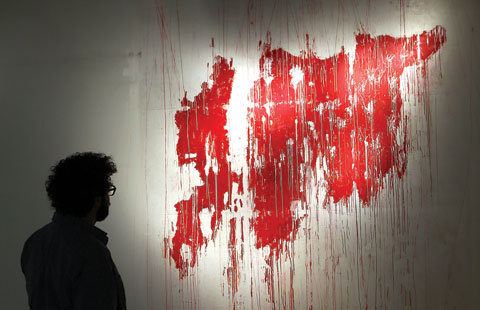
"I used the Syrian map as an icon," Azzam told AFP. "This map had never meant anything to me during my whole life before. Suddenly, I had a new-discovered nation."
In many of his works, Azzam, who hails from Syria's Druze minority heartland city of Sweida, extensively uses the map of his country -- where more than 41,000 people have been killed since protests against President Bashar al-Assad's regime erupted in March 2011, according to a watchdog.
Another artwork shows pieces of the Syrian map burning and falling apart while yet another one portrays it in red, hit by a bullet in its centre, sitting over the United Nations logo -- also in red instead of its original blue colour.
This work, as many of his pieces, strongly criticises the failure of the international community to end the bloodshed in Syria.
A part of the exhibition titled "The Syrian Museum" showcases more expensive works combining photographs of the destruction in Syria and famous paintings such as Leonardo Da Vinci's "Mona Lisa", Edvard Munch's "Scream" and Francisco Goya's "The Third of May 1808".
"How could these civilised nations that claim to support humanity commemorate a painting for Goya because it represents a massacre on one day in the history of the Spanish... whereas they forget that every single day we have a Third of May in Syria?" asks Azzam.
The artist has added part of Goya's painting portraying field executions to a photograph of destruction in Syria.
Other works reflect Azzam's nostalgia towards his homeland from which he fled a year ago for fear of being called up for reservist duty in the army, which stands accused by the opposition of carrying out atrocities across the country.
In one picture named "Where We Were", a little girl points to a spot she remembers on the Earth -- Syria.
In another, a black map of Syria hangs from a laundry line. "Laundry represents the memories one leaves behind," explains the 32-year-old artist with a distant sparkle in his dark eyes.
But a nearby lively work portrays piles of debris ironically in bright blocks of colour. "To me, even this destruction is still my colourful country. It is still the place that concerns me," he says.
Azzam says taking up arms in Syria was the only choice people had "because the scale of oppression and violations is different from anything that has happened throughout human history".
But he himself "couldn't carry a gun".
------------------------------------------------------------------------------------------------
In many of his works, Azzam, who hails from Syria's Druze minority heartland city of Sweida, extensively uses the map of his country -- where more than 41,000 people have been killed since protests against President Bashar al-Assad's regime erupted in March 2011, according to a watchdog.
Another artwork shows pieces of the Syrian map burning and falling apart while yet another one portrays it in red, hit by a bullet in its centre, sitting over the United Nations logo -- also in red instead of its original blue colour.
This work, as many of his pieces, strongly criticises the failure of the international community to end the bloodshed in Syria.
A part of the exhibition titled "The Syrian Museum" showcases more expensive works combining photographs of the destruction in Syria and famous paintings such as Leonardo Da Vinci's "Mona Lisa", Edvard Munch's "Scream" and Francisco Goya's "The Third of May 1808".
"How could these civilised nations that claim to support humanity commemorate a painting for Goya because it represents a massacre on one day in the history of the Spanish... whereas they forget that every single day we have a Third of May in Syria?" asks Azzam.
The artist has added part of Goya's painting portraying field executions to a photograph of destruction in Syria.
Other works reflect Azzam's nostalgia towards his homeland from which he fled a year ago for fear of being called up for reservist duty in the army, which stands accused by the opposition of carrying out atrocities across the country.
In one picture named "Where We Were", a little girl points to a spot she remembers on the Earth -- Syria.
In another, a black map of Syria hangs from a laundry line. "Laundry represents the memories one leaves behind," explains the 32-year-old artist with a distant sparkle in his dark eyes.
But a nearby lively work portrays piles of debris ironically in bright blocks of colour. "To me, even this destruction is still my colourful country. It is still the place that concerns me," he says.
Azzam says taking up arms in Syria was the only choice people had "because the scale of oppression and violations is different from anything that has happened throughout human history".
But he himself "couldn't carry a gun".
------------------------------------------------------------------------------------------------









 Home
Home Politics
Politics









